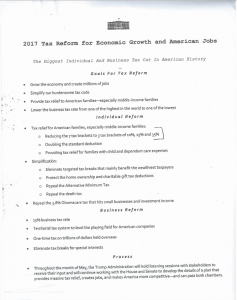Here are the key elements in the tax plan proposed by President Trump:
Three Tax Brackets:
The number of tax brackets for individuals is reduced from seven to three: 10 percent, 25 percent and 35 percent. That lowers the top rate by nearly 5 percentage points, easing the tax burdens on most Americans, including the rich.
Those rates are slightly different than those Trump proposed during the campaign. The new plan increases the top rate to 35 percent from 33 percent in the old plan and lowers the bottom rate to 10 percent, from 12 percent in the old plan.
The Trump administration did not say where those brackets begin and end. The one-page plan (see below) doesn’t spell out exactly where each tax bracket will fall like his original tax proposal.
Standard Deductions Increase:
The standard deduction would nearly double under Trump’s proposal, but it’s less than what he offered during the campaign.
“We are going to double the standard deduction so a married couple wouldn’t pay any taxes on the first $24,000 income they earn. So in essence, we are creating a zero tax rate — yes, a zero tax rate — for the first $24,000 that a couple earns,” said Gary Cohn, head of Trump’s National Economic Council, during the news conference rolling out the new plan.
Currently, individuals can deduct $6,350 and married couples can deduct $12,700 from their taxable income. Mr. Trump’s plan would double the standard deduction. That is intended to put more money in the pockets of the average taxpayers who do not itemize their deductions. It has the added benefit of simplifying the preparation of tax returns for more people.
Alternative Minimum Tax (A.M.T):
The Trump administration remains committed to ending the alternative minimum tax, known as the AMT. It requires more than 5 million taxpayers to calculate their liability twice and then ay the higher amount.
The alternative minimum tax makes it harder for very rich individuals to game the tax system and pay less tax. It is an aggravating tax for the well-to-do, what Treasury Secretary Steven T. Mnuchin called a “complicated” additional system of taxation.
Lower Capital Gains Tax
Under the plan, the top federal capital gains rate is cut from 23.8 percent to 20 percent. This is achieved by eliminating a 3.8 percent tax that is used to fund the Affordable Care Act. The reduction is meant to create greater incentives for people to invest.
The tax applies to investment income of taxpayers with a modified adjusted gross income of more than $200,000 for single filers and $250,000 for married couples filing jointly. Ending the net income investment tax would drop the effective capital gains tax rate for high earners from 23.8 percent to 20 percent.
Here are the key elements in the tax plan proposed by President Trump:
Three Tax Brackets:
The number of tax brackets for individuals is reduced from seven to three: 10 percent, 25 percent and 35 percent. That lowers the top rate by nearly 5 percentage points, easing the tax burdens on most Americans, including the rich.
Those rates are slightly different than those Trump proposed during the campaign. The new plan increases the top rate to 35 percent from 33 percent in the old plan and lowers the bottom rate to 10 percent, from 12 percent in the old plan.
The Trump administration did not say where those brackets begin and end. The one-page plan (see below) doesn’t spell out exactly where each tax bracket will fall like his original tax proposal.
Standard Deductions Increase:
The standard deduction would nearly double under Trump’s proposal, but it’s less than what he offered during the campaign.
“We are going to double the standard deduction so a married couple wouldn’t pay any taxes on the first $24,000 income they earn. So in essence, we are creating a zero tax rate — yes, a zero tax rate — for the first $24,000 that a couple earns,” said Gary Cohn, head of Trump’s National Economic Council, during the news conference rolling out the new plan.
Currently, individuals can deduct $6,350 and married couples can deduct $12,700 from their taxable income. Mr. Trump’s plan would double the standard deduction. That is intended to put more money in the pockets of the average taxpayers who do not itemize their deductions. It has the added benefit of simplifying the preparation of tax returns for more people.
Alternative Minimum Tax (A.M.T):
The Trump administration remains committed to ending the alternative minimum tax, known as the AMT. It requires more than 5 million taxpayers to calculate their liability twice and then ay the higher amount.
The alternative minimum tax makes it harder for very rich individuals to game the tax system and pay less tax. It is an aggravating tax for the well-to-do, what Treasury Secretary Steven T. Mnuchin called a “complicated” additional system of taxation.
Lower Capital Gains Tax
Under the plan, the top federal capital gains rate is cut from 23.8 percent to 20 percent. This is achieved by eliminating a 3.8 percent tax that is used to fund the Affordable Care Act. The reduction is meant to create greater incentives for people to invest.
The tax applies to investment income of taxpayers with a modified adjusted gross income of more than $200,000 for single filers and $250,000 for married couples filing jointly. Ending the net income investment tax would drop the effective capital gains tax rate for high earners from 23.8 percent to 20 percent.




